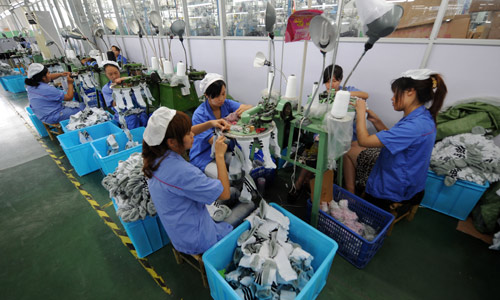|
 |
|
BUILDING A BRAND: Companies in labor-intensive industries are focusing on improving the quality of their products and creating brand recognition (HAN CHUANHAO) |
Developed countries have adopted a string of measures to tide over the crisis, including such short-term ones as trade protectionism and currency depreciation, as well as long-term ones like reindustrialization, said the report.
One key aspect of the transition is to reframe the international competition order by promoting low-carbon growth in all economies.
Developed countries have experienced three stages of development pattern transformation, with the first focusing on productivity enhancement, from a pattern with extensive resource utilization to one featuring resource-efficient growth; and the second on the protection of domestic fledgling industries to nurture their global competitiveness. Currently they are undertaking the transition to a low-carbon economic growth. China, however, must accomplish all the three major tasks within a short period of time, thereby facing a grim challenge to catch up quickly and join the race, Zhang said.
Development difficulties
Next year, as China will begin to implement its 12th Five-Year Plan (2011-15), the major risks to its industrial competitiveness boost during this period will become evident, and the main dilemma that will stick out is its lack of new industries with competitive advantages, the report said.
China has broken into the ranks of middle-income countries and is moving up the income ladder toward high-income nations. To fulfill this goal, China must identify new industrial strengths and complete the transition while watching out for a "vacuum" of industrial competitiveness that may appear, the report said.
There are several reasons for the "vacuum": declining cost advantages, difficulties in upgrading industrial sectors for resource-efficient and innovation-intensive growth, and a weak capacity to develop low-carbon advantages to name a few.
China has obtained its industrial competitiveness at the global market largely through slashing production costs. But labor and environment costs have escalated following China's three-decade economic boom, and in labor-intensive industries the country is confronted with severe challenges from low-income countries.
Meanwhile, China has to compete with developed countries in developing technology-intensive industries in order to become a member of the high-income camp. It's very likely a vacuum will appear when China relies more on technology-intensive products than on labor-intensive goods, the report said.
The vacuum is already a reality in some coastal regions. "Whether China can dissolve the risk of the short-term absence of industrial competitiveness in these regions and prevent the regional absence from evolving into a national one will remain a formidable task in the near future," Zhang said.
In addition, the essence of development pattern transformation is industrial upgrading, making the industries capable of promoting economic growth and facilitating to the new development pattern, the report said.
Experts have so far found that none of China's industries meet both requirements.
"For the goal of maintaining high economic growth, we favor backbone industries with good foundations that help boost the production of other industries. But these industries are usually energy-consuming and carbon-spewing ones," Zhang said.
But if China wants to develop eco-friendly, resource-efficient industries that boost employment, it should prioritize the service industry, he said.
Before the financial crisis, China had already adopted measures to reduce contributions from the secondary industry to its economic growth and boost the competitive advantages of the tertiary industry. But such efforts have slowed the pace of economic growth. During the current phase of development, the country should seek ways for the transformation of the development pattern while maintaining its economic growth, he said.
China's comparatively weak low-carbon competitiveness is another obstacle. The intensity of China's carbon dioxide emissions was high from the 1970s to the mid-1990s, and it has only decreased slightly since the late 1990s.
China still faces great difficulties in its endeavor to sharpen its industrial competitiveness by means of cutting the carbon emission intensity. "This is largely because the high proportion of coal in the country's energy consumption structure has remained unchanged, despite the numerous measures adopted to develop new energies and improve energy conservation," Zhang said.
In addition, the carbon intensity of China's exports is higher than that of many developed countries, which will affect its industrial competitiveness, too. The adoption of carbon tariffs in many Western countries will throw a heavy blow on exports from countries with high carbon intensity.
China has to optimize the pace and route of its growth pattern transformation, otherwise, the goal may not be achieved, the report said. And China should rev up research and development efforts on core technologies in traditional industries, putting the brake on the declining competitiveness. Efforts should also be pooled to boost R&D in strategic emerging industries, especially in the new energy industry, and establish an effective mechanism for the discovery of future dominant industries and technologies. The structure of imports should be improved too, to beef up imports of advanced technologies and hi-tech products. | 